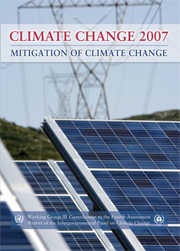 Climate Change 2007 - Mitigation of Climate Change
Climate Change 2007 - Mitigation of Climate Change Book contents
- Frontmatter
- Contents
- Foreword
- Preface
- Summary for Policymakers
- Technical Summary
- 1 Introduction
- 2 Framing issues
- 3 Issues related to mitigation in the long term context
- 4 Energy supply
- 5 Transport and its infrastructure
- 6 Residential and commercial buildings
- 7 Industry
- 8 Agriculture
- 9 Forestry
- 10 Waste management
- 11 Mitigation from a cross sectoral perspective
- 12 Sustainable Development and mitigation
- 13 Policies, instruments and co-operative agreements
- Annex I Glossary
- Annex II Acronyms, abbreviations and chemical compounds
- Annex III List of contributors
- Annex IV List of reviewers
- Index
1 - Introduction
- Frontmatter
- Contents
- Foreword
- Preface
- Summary for Policymakers
- Technical Summary
- 1 Introduction
- 2 Framing issues
- 3 Issues related to mitigation in the long term context
- 4 Energy supply
- 5 Transport and its infrastructure
- 6 Residential and commercial buildings
- 7 Industry
- 8 Agriculture
- 9 Forestry
- 10 Waste management
- 11 Mitigation from a cross sectoral perspective
- 12 Sustainable Development and mitigation
- 13 Policies, instruments and co-operative agreements
- Annex I Glossary
- Annex II Acronyms, abbreviations and chemical compounds
- Annex III List of contributors
- Annex IV List of reviewers
- Index
Summary
EXECUTIVE SUMMARY
The ultimate objective of the United Nations Framework Convention on Climate Change (UNFCCC) is to achieve the stabilization of greenhouse gas (GHG) concentrations in the atmosphere at a level that would prevent dangerous anthropogenic interference with the climate system. Such a level should be achieved within a time frame sufficient to allow ecosystems to adapt naturally to climate change, to ensure that food production is not threatened and to enable economic development to proceed in a sustainable manner (Article 2).
This Chapter discusses Article 2 of the Convention within the framework of the main options and conditions under which it is to be implemented, reflects on past and future GHG emission trends, highlights the institutional mechanisms currently in place for the implementation of climate change and sustainable development objectives, summarizes changes from previous assessments and provides a brief roadmap for the ‘Climate Change 2007: Mitigation of Climate Change’ assessment.
Defining what is dangerous anthropogenic interference with the climate system and, consequently, the limits to be set for policy purposes are complex tasks that can only be partially based on science, as such definitions inherently involve normative judegments. Decisions made in relation to Article 2 will determine the level of GHG concentrations in the atmosphere (or the corresponding climate change) that is set as the goal for policy and have fundamental implications for emission reduction pathways as well as the scale of adaptation required.
- Type
- Chapter
- Information
- Climate Change 2007 - Mitigation of Climate ChangeWorking Group III contribution to the Fourth Assessment Report of the IPCC, pp. 95 - 116Publisher: Cambridge University PressPrint publication year: 2007
- 2
- Cited by
